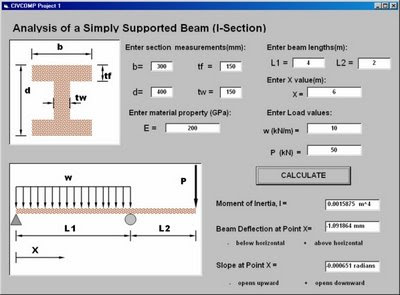
Hangeneering by J.P. Sy and D. Baluyot. Based on the game, "Hangman", this is a game to test the student’s mastery on solving reactions in statically determinate beams. There is a time limit which varies from 30 seconds to 90 seconds depending on the level of difficulty. The program chooses randomly the figure and the beam parameters. There is a formula for getting the score of the player. The game will be over when the user answered incorrectly three times or when the time has run out. This game can be played in the Engineering Mechanics (Statics) or Strength of Materials class.
 Jeopardeng by C. Fabie and R. Masa: This is an adaptation of the famous American game Jeopardy. The game has four different categories that cover various topics about civil engineering. Each category has four objective questions. There is a data base of questions which are selected randomly. The user answers all questions under the four categories in any order, aiming to bag a high score. After all questions have been answered within the time limit, the user is prompted to the “Final JeopardENG Round”; wherein a computational question will be asked to the user worth 5000 points.
Jeopardeng by C. Fabie and R. Masa: This is an adaptation of the famous American game Jeopardy. The game has four different categories that cover various topics about civil engineering. Each category has four objective questions. There is a data base of questions which are selected randomly. The user answers all questions under the four categories in any order, aiming to bag a high score. After all questions have been answered within the time limit, the user is prompted to the “Final JeopardENG Round”; wherein a computational question will be asked to the user worth 5000 points.
This game can be played in class to review the students about civil engineering terms, concepts and definitions. A competition among students can be done with the student having the highest score declared as the winner.

 Dr. Naveed Anwar is the Associate Director of ACECOMS and an Affiliate Faculty of the School of Engineering and Technology of the Asian Institute of Technology, Bangkok, Thailand. Dr. Naveed is the principal author of several engineering software including SDL, GEAR, SYSDesigner. He is also a consultant of CSI, the developer of ETABS, CSI Col, SAFE and SAP2000.
Dr. Naveed Anwar is the Associate Director of ACECOMS and an Affiliate Faculty of the School of Engineering and Technology of the Asian Institute of Technology, Bangkok, Thailand. Dr. Naveed is the principal author of several engineering software including SDL, GEAR, SYSDesigner. He is also a consultant of CSI, the developer of ETABS, CSI Col, SAFE and SAP2000.

 Prof. Emeritus Per Tveit, Dr. Ing. of Agder University, Norway, visited De La Salle University, Manila a few years ago to share his knowledge and expertise about Network Arches. "When I was a student over 50 years ago, I got the idea of the network arch. Optimal network arches are arch bridges where some hangers cross other hangers at least twice. When the arches are less than 18 m apart, the tie should be a concrete slab with partial longitudinal prestress. The arches should be universal columns or American wide flanges. Network arches are best suited for spans between 80 m and 170 m, but will compete well in a wider range of spans. This results in attractive bridges that do not hide the landscape behind them. A network arch bridge is likely to remain the world’s most slender tied arch bridge, " he says. Indeed, Tveit can be considered the "father of network arches." He traveled around the world using his own resources spreading the information about network arches - the basic components, analysis, design and construction. His website has detailed information about network arches.
Prof. Emeritus Per Tveit, Dr. Ing. of Agder University, Norway, visited De La Salle University, Manila a few years ago to share his knowledge and expertise about Network Arches. "When I was a student over 50 years ago, I got the idea of the network arch. Optimal network arches are arch bridges where some hangers cross other hangers at least twice. When the arches are less than 18 m apart, the tie should be a concrete slab with partial longitudinal prestress. The arches should be universal columns or American wide flanges. Network arches are best suited for spans between 80 m and 170 m, but will compete well in a wider range of spans. This results in attractive bridges that do not hide the landscape behind them. A network arch bridge is likely to remain the world’s most slender tied arch bridge, " he says. Indeed, Tveit can be considered the "father of network arches." He traveled around the world using his own resources spreading the information about network arches - the basic components, analysis, design and construction. His website has detailed information about network arches. 





